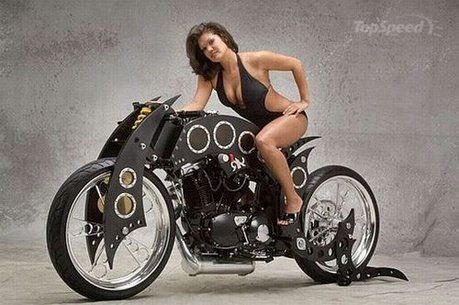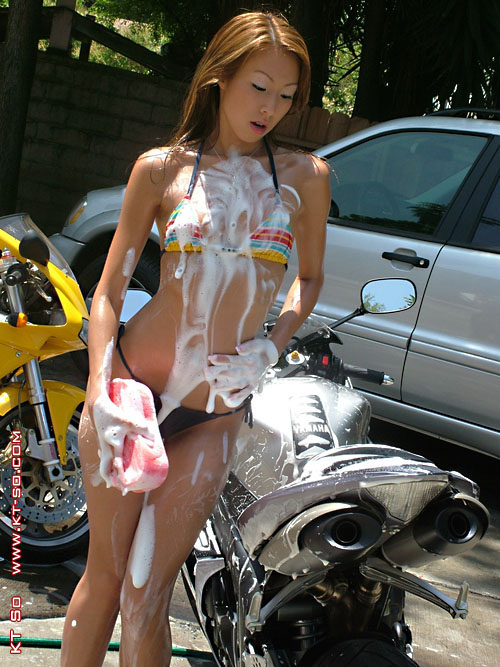THIS IS THE OFFICIAL Kimmycruz BLOG
photographer, model, bartender,
and promoter for more than a decade
at the biggest and baddest rallies the
USA has to offer.
I love everybody, and just being Kimmycruz makes me happier than I've ever been in my life.
Now fans can follow Kimmycruz across the USA at her "official blog" for photo updates and rally stories, linked to Kimmycruz.com.
Story by Wendy Manning, Photos courtesy of Kimmy Cruz's private collection
Michael Ballard's Full Throttle Saloon has been the subject of a reality series on truTV called, appropriately, Full Throttle Saloon. Unlike other rally documentaries this one stayed with Ballard and his Full Throttle crew the whole time, giving us an insider's view of what it really takes to run the self-proclaimed "World' Largest Biker Bar" during the make-it or break-it ten day event. If you were a fan of the show, you more than likely caught a few glimpses of Kimmy Cruz.
Kimmy started out selling ads for various motorcycle magazines. “In addition to that, I began writing stories and doing photography, as well as marketing and promotion,” she explained. “From there, I met so many people because I was out and about at all the major rallies, and I ended up modeling for all the top builders.” She started her bartending career at Broken Spoke Saloon during the 2002 Daytona Bike Week. When Broken Spoke owner Jay Allen asked her tend bar, she was apprehensive because she’d never tended bar before. “He told me I could just crack open the beer, I wouldn’t have to serve liquor or anything. He brought out a ’57 Chevy and set me up with a beer tub. We were so packed—I had so much fun. I served ninety-six cases of beer in four hours. I didn’t know what to think.” But it didn’t take long for Kimmy to figure out that having made $900 in tips during those four hours, tending bar at bike rallies was a great way for her to supplement her income. “What would I say, no? I said bring it on, because I knew I could work and make extra money on top of being a sales rep. I ended up fading out the sales rep job because I figured why am I doing this for other people when they’re making thousands of dollars off me? I made a better income as a bar tender at bike rallies.”
Kimmy took three months off to educate herself on the art and nuances of bartending, upgrading her photography skills, and building a website for herself, her photography, and her modeling career. That was nearly nine years ago, and she’s been going strong ever since.
Kimmy goes to rallies that draw 400,000 people and more. “I picked at least six different locations where I knew I could make money. I introduced myself to every vender and took photos of them, and I try to promote everyone across the board, whether they’re a client, a vender, a bar owner, a customer, or a friend,” she said. “I made sure I made lots of friends and I helped out wherever I could. So all these people were seeing me. That’s how I met Michael Ballard. I was a model for aftermarket retailer Dennis Kirk at the time.” Kimmy was set up at the Dennis Kirk booth on the Full Throttle property, and she says Michael asked when she planned to work for him as a bartender. “At that time I wasn’t working full time, I was trying different things, so in 2007 I went to work at Full Throttle. It’s an awesome atmosphere. Everybody loves Full Throttle.”
Being a bartender at Full Throttle isn’t all fun and games, however. Bartenders work very hard. If you watched the show on truTV, you know that surveillance cameras catch all the action at each bar, and the security team is watching every move the staff makes. You saw employees go through the rigorous hiring process, and you probably some of them being “let go” before the rally was over. As a bartender customers are allowed to photograph you, and you’re required to comply and you cannot charge money for photographs taken.
But Kimmy says despite the hard work, working as a rally bartender helps her to make contacts to other jobs. “Plus, I get to meet all the top builders,” she said. “I get to meet Ron Finch, Billy Lane, and Jesse James, all of them really. And they’ve always been super nice to me.”
So making good money, having fun and making friends, tending bar at major bike rallies is something Kimmy highly recommends. But the competition is steep. “They don’t call you or anything,” she explained. “To get back with Full Throttle I’ll have to go through the application process just like everybody else.”
To check out Kimmy Cruz, or ask her advice on how to get started as a rally bartender, visit her website at kimmycruz.com.




































_DN-SN-82-04758.jpg)

























